
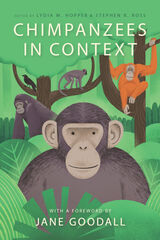
After a foreword by Jane Goodall, the book features sections that examine chimpanzee life histories and developmental milestones, behavior, methods of study, animal communication, cooperation, communication, and tool use. The book ends with chapters that consider how we can apply contemporary knowledge of chimpanzees to enhance their care and conservation. Collectively, these chapters remind us of the importance of considering the social, ecological, and cognitive context of chimpanzee behavior, and how these contexts shape our comprehension of chimpanzees. Only by leveraging these powerful perspectives do we stand a chance at improving how we understand, care for, and protect this species.
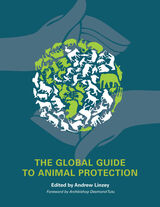
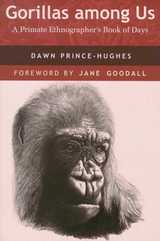
Dawn Prince-Hughes is an extraordinary researcher. She does not experiment or measure but instead sits on a wooden bench for hours each day, watching captive gorillas through the enclosure where other visitors average five-second stops. Her patience is rewarded with astounding observations—she watches gorillas make and use tools, bury a dead crow, give birth, and comfort and care for each other.
In Gorillas among Us, Prince-Hughes has compressed years of gorilla observation into a composite diary chronicling the days of one gorilla family. She creates a blended portrait of both peoples—gorilla and human. The entries capture significant observations, which often prompt brief discussions of gorillas’ captivity, diet, communication, aesthetic preferences, social behavior, and play. Several chapters end with thought-provoking meditations on human values. The final section, “More about Gorillas,” provides a concise, accessible introduction to gorilla natural history.
This book will delight and move anyone with an interest in animals, and it also makes a significant contribution to the scarce literature on captive gorillas. Prince-Hughes's observations of tool use by gorillas will interest scientists, and even a casual reader will come away with a new sense of the power of observation. The author hopes to change the way we look at animals in the wild and in captivity, and laments that zoo visitors pause so briefly in front of the gorilla enclosure, rushing on with their assumptions unchanged, without really seeing the gorillas.
By turns opinionated and descriptive, quirky and authoritative, Prince-Hughes draws us into the family life of captive gorillas and into a consideration of our own culture. Readers will learn something new about gorillas and themselves on every page of this poignant story. The book testifies to the potential for interspecies compassion and the love that one person can find in a family of gorillas.
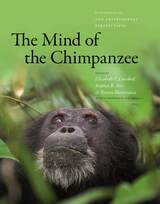
Understanding the chimpanzee mind is akin to opening a window onto human consciousness. Many of our complex cognitive processes have origins that can be seen in the way that chimpanzees think, learn, and behave. The Mind of the Chimpanzee brings together scores of prominent scientists from around the world to share the most recent research into what goes on inside the mind of our closest living relative.
Intertwining a range of topics—including imitation, tool use, face recognition, culture, cooperation, and reconciliation—with critical commentaries on conservation and welfare, the collection aims to understand how chimpanzees learn, think, and feel, so that researchers can not only gain insight into the origins of human cognition, but also crystallize collective efforts to protect wild chimpanzee populations and ensure appropriate care in captive settings. With a breadth of material on cognition and culture from the lab and the field, The Mind of the Chimpanzee is a first-rate synthesis of contemporary studies of these fascinating mammals that will appeal to all those interested in animal minds and what we can learn from them.
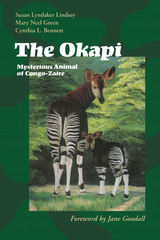
Congo-Zaire contains Africa's largest remaining tracts of intact rain forest, making it one of the most important regions for biodiversity conservation. Its Ituri Forest is home to plants and animals native to nowhere else on earth, including the elusive and little-known okapi.
In this popularly written book, three long-time observers of the okapi present a complete, contemporary natural history of this appealing relative of the giraffe. They recount its discovery by European explorers and describe its appearance and life cycle. They also discuss current efforts to preserve the species, both in the wild and at zoos around the world.
Illustrated with charming line drawings, The Okapi will be a valuable resource for conservationists and zoo visitors alike-indeed anyone fascinated by the mysterious animal of Congo-Zaire.

Thanks to classic studies such as Jane Goodall's The Chimpanzees of Gombe, we know a great deal about our closest primate relative, but much remains to be discovered about these endlessly fascinating family members. Even their genus name, Pan, taken from the Greek god who represented the spirit of nature, aptly characterizes their elusiveness, for, like nature, chimpanzee behavior is a "giant jigsaw puzzle," as Goodall puts it. This book, a definitive summary of current knowledge about chimpanzees and bonobos, is a significant step toward solving the puzzle.
Virtually every major chimpanzee specialist from around the world--Japan, the Netherlands, Great Britain, Africa, the United States--has contributed to this landmark volume. It contains important contributions by Japanese researchers who have been working in Africa for as many years as Goodall and whose work is not readily accessible in the West.
Understanding Chimpanzees examines a wide range of topics, including social behavior and ecology in the field, the rich variety of cultural traditions between one population and another in Africa and elsewhere, behavior in captivity, and the incredible cognitive abilities of chimpanzees in language acquisition laboratories. Of special interest is the strong coverage of bonobos (pygmy chimpanzees). The authors also concentrate on conveying a better appreciation of chimpanzee intelligence through the description of various ongoing investigations, particularly ones that examine signing interactions, vocabulary testing and modulation, and symbol acquisition.
In addition to the Foreword, Jane Goodall contributes a review of her own work at Gombe, her proposal for a "ChimpanZoo" project, and an update on the status of conservation in Tanzania. The book contains a major section on chimpanzee conservation in captivityand in the wild, documenting the threat to chimpanzee habitat and survival.
This work draws from a broad range of disciplines, including ethology, psychology, anatomy, biology, anthropology, conservation, and ecology and will attract readers pursuing ideas in all these fields. Over 100 photographs and drawings illustrate the text, which has been carefully assembled and edited by Paul G. Heltne, Director of the Chicago Academy of Sciences, and Linda A. Marquardt, the editor of Science Learning in the Informal Setting.
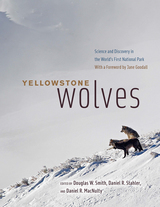
Here, for the first time in a single book, is the incredible story of the wolves’ return to Yellowstone National Park as told by the very people responsible for their reintroduction, study, and management. Anchored in what we have learned from Yellowstone, highlighting the unique blend of research techniques that have given us this knowledge, and addressing the major issues that wolves still face today, this book is as wide-ranging and awe-inspiring as the Yellowstone restoration effort itself. We learn about individual wolves, population dynamics, wolf-prey relationships, genetics, disease, management and policy, newly studied behaviors and interactions with other species, and the rippling ecosystem effects wolves have had on Yellowstone’s wild and rare landscape. Perhaps most importantly of all, the book also offers solutions to ongoing controversies and debates.
Featuring a foreword by Jane Goodall, beautiful images, a companion online documentary by celebrated filmmaker Bob Landis, and contributions from more than seventy wolf and wildlife conservation luminaries from Yellowstone and around the world, Yellowstone Wolves is a gripping, accessible celebration of the extraordinary Yellowstone Wolf Project—and of the park through which these majestic and important creatures once again roam.
READERS
Browse our collection.
PUBLISHERS
See BiblioVault's publisher services.
STUDENT SERVICES
Files for college accessibility offices.
UChicago Accessibility Resources
home | accessibility | search | about | contact us
BiblioVault ® 2001 - 2025
The University of Chicago Press









